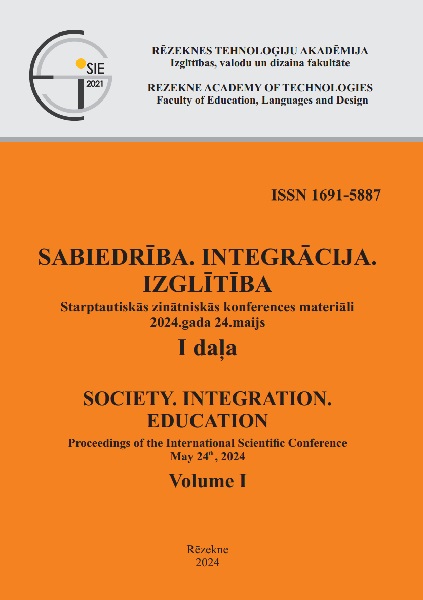PUPILS' RIGHTS AND RESPONSIBILITIES IN CONFLICTS BETWEEN PUPILS AND TEACHERS
DOI:
https://doi.org/10.17770/sie2024vol1.7874Keywords:
causes of conflict, conflict between pupil and teacher, means of conflict resolution, pupil‘s rights and duties, schoolAbstract
This paper aims to reveal students' reactions to a conflict situation due to the nonimplementation of students' rights and duties. The data was collected by the means of a questionnaire (anonymous survey). The participants of the study were 241 pupils of a general education school (grades 5-8). The data show that conflicts between pupils and teachers are a daily occurrence. Conflicts between pupils and teachers arise from teacher‘s behaviour that ignores or violates pupil‘s rights: when the teacher explains the subject in an uninteresting way (60.2%); when teacher assigns too many tasks for pupils (58.9%); expresses negative bias towards the pupil (34.4%); teacher restricst pupil‘s independence (34.4%); teacher ignores the pupil‘s abilities (29.4%); teatcher does not assist the pupil (22%); teacher discriminates against the pupil (14.9%); or teacher behaves rudely towards the pupil (13.2%). The survey revealed that pupils tend to be passive during conflicts with the teacher: 47.8% of the pupils chooses avoidance strategy, 52.3% adapt, 29.9% of the pupils chooses the strategy of indirect protest, 6.6% of the pupils chooses direct aggression tactics (saying something offensive, refusing to do the task, etc.). Correlation analysis shows that conflict is most likely to occur when the teacher penalises pupil‘s misbehaviour through grading, when the teacher fails to notice the pupil‘s efforts, and when the teacher fails to help the pupil. As the teacher is the one who is responsible for building the pupil-teacher relationship, the teacher must take the lead in fostering a relationship of dignity and respect with the pupil by exercising his/her rights and resolving conflicts in a constructive way.
References
Blunk, E., Russell, E., &Armga, C. J. (2017). The role of teachers in peer conflict: implications for teacher reflections. Teacher Development, 21(5), 597–608.
Chen, Sh., Phillips, B., &Izci, B. (2018). Teacher–child relational conflict in Head Start –exploring the roles of child behaviour, teacher stress, and bias, and classroom environment. Early Child Development and Care, 190(8), 1174–1186. DOI: 10.1080/03004430.2018.1524378
Čiuladienė, G. (2013). Paauglių konfliktai ir jų sprendimas ugdymo realybėje. Vilnius: Mykolo Romerio universitetas.
Čiuladienė, G. (2018). The weak aspects of conflict Management skills of youth: considering weak features. In P. Brey &M. Rzepecka (ed.), Communication and Conflict in Multiple Settings (13-35). Boston: Rodopi.
Čiuladienė, G., &Kairienė, B. (2017). The resolution of conflict between teacher and student: students' narratives. Journal of teacher education for sustainability, 19(2), 107–120. DOI: 10.1515/jtes-2017-0017.
Čiuladienė, G., &Kairienė, B. (2018). The resolution of conflict between teacher and student: teachers’ narratives. Society, integration, education: proceedings of the international scientific conference, 3, 235–245. DOI: 10.17770/sie2018vol1.3249.
Duckworth, C., Albano, T., Munroe, D., &Garver, M. (2019). Students can change a school: Understanding the role of youth leadership in building a school culture of peace. Conflict Resolution Quarterly, 36, 235–249. https://doi.org/10.1002/crq.21245
Erikson, E. H. (2004). Vaikystė ir visuomenė. Vilnius: Katalikų pasaulio leidiniai.
Gaižauskaitė, I., &Mikėnė, S. (2014). Socialinių tyrimų metodai: apklausa. Vilnius: Mykolo
Romerio universitetas.
Garrard, W. M., &Lipsey, M.W. (2007). Conflict resolution education and antisocial behavior
in U.S. schools: A meta-analysis. Conflict Resolution Quarterly, 25(1), 9–38.
General Assembly (1989). Convention on the Rights of the Child. Retrieved from: https://www.ohchr.org/en/instruments-mechanisms/instruments/convention-rights-child
Guilherme, A. (2017). Understanding conflict resolution philosophically in a school setting: three different kinds of violence and dialogue. Journal of Peace Education, 14(2), 215–234. DOI: 10.1080/17400201.2017.1323728
Jegelevičienė, V., Merfeldaitė, O, &Railienė, A. (2016). Mokinių mokymosi motyvacijos silpnėjimo priežastys: tėvų požiūris. Pedagogika, 124(4), 117–128.
Hakvoort, I. (2010). The conflict pyramid: a holistic approach to structuring conflict resolution in schools. Journal of Peace Education, 7(2), 157–169.
Hargreaves, E., &Elhawary, D. (2019). Professional development through mutually respectful relationship: senior teachers’ learning against the backdrop of hierarchical relationships. Professional Development in Education, 45(1), 46–58, DOI: 10.1080/19415257.2018.1500390
Hendrickx, M. M., Mainhard, M. T., Boor-Klip, H. J., Cillessen, A., &Brekelmans, M. (2016).
Social dynamics in the classroom: Teacher support and conflict and the peer ecology.
Teaching and Teacher Education, 53, 30–40.
Kairienė, B. (2017). Mokinio pareigos: įgyvendinimo problema. Pedagogika, 126(2), 130-142.
Kairienė, B. (2023). Vaiko teisių ir pareigų santykis: įgyvendinimo prielaidos. In Visuomenės pokyčiai ir teisė. Liber Amicorum Vytautui Šlapkauskui: straipsnių rinkinys (198–217). Šiauliai: Šiaulių spaustuvė.
Kardelis, K. (2007). Mokslinių tyrimų metodologija ir metodai: (edukologija ir kiti socialiniai
mokslai): vadovėlis (4-asis leid. ed.). Šiauliai: Lucilijus.
Kvieskienė, G. (2005). Pozityvioji socializacija. Vilnius: Vilniaus Pedagoginis universitetas.
Martišauskienė, E., &Vaičekauskienė, S. (2016). Santykiai mokykloje: išorinis vertinimas.
Pedagogika, 121, 83–100.
Navaitienė, J., &Jaruševičienė, V. (2018). Mokytojų asmenybės bruožai ir pyktis. Pedagogika,
(4), 23–41. https://doi.org/10.15823/p.2018.132.2
Petrulytė, A. (2012). Paauglio psichosocialinė raida. Mokymo priemonė. Vilnius: edukologija.
Piaget, J. (2011). Vaiko pasaulėvoka. Vilnius: Žara.
Roorda, D. L., Koomen, H. M., Spilt, J., L., &Oort, F. J. (2011). The Influence of Affective Teacher-Student Relationship on Students‘ School Engagement and Achievement: A Meta-Analytic Approach. Review of Educational Research, 81(4), 493–529.
Runions, K. C., &Shaw, T. (2013). Teacher-child relationship, child withdrawal and aggression in the development of peer victimization. Journal of Applied Developmental Psychology, 34(6), 319–327.
Sellman, E. (2011). Peer mediation services for conflict resolution in schools: what transformations in activity characterize successful implementation? British Educational Research Journal, 37(1), 45–60.
Skalicka, V., Belsky, J., &Stenseng, F. (2015). Reciprocal Relations Between Student-Teacher Relationship and Children‘s Behavioral Problems: Moderation by Child-Care Group Size. Child Development, 86(5), 1557–1570. DOI: 10.1111/cdev.12400
Supreme Council of the Republic of Lithuania - Reconstituted Seimas (1991). Law on Education. Retrieved from: https://e-seimas.lrs.lt/portal/legalAct/lt/TAD/TAIS.180/asr
UN Committe on the Rihgts of the Child (2001). General Comment 1: The aims of education. Retrieved from: https://tbinternet.ohchr.org/_layouts/15/treatybodyexternal/Download.aspx?symbolno=CRC%2FGC%2F2001%2F1&Lang=en
Wang, C., Harrison, L. J., McLeod, Sh., Walker, S., &Spilt, J. L. (2018). Can teacher–child
relationships support human rights to freedom of opinion and expression, education and participation? International Journal of Speech-Language Pathology, 20(1), 133–141.
Wilmot, W. W., &Hocker, J. L. (2001). Interpersonal conflict. Boston: McGraw-Hill.






